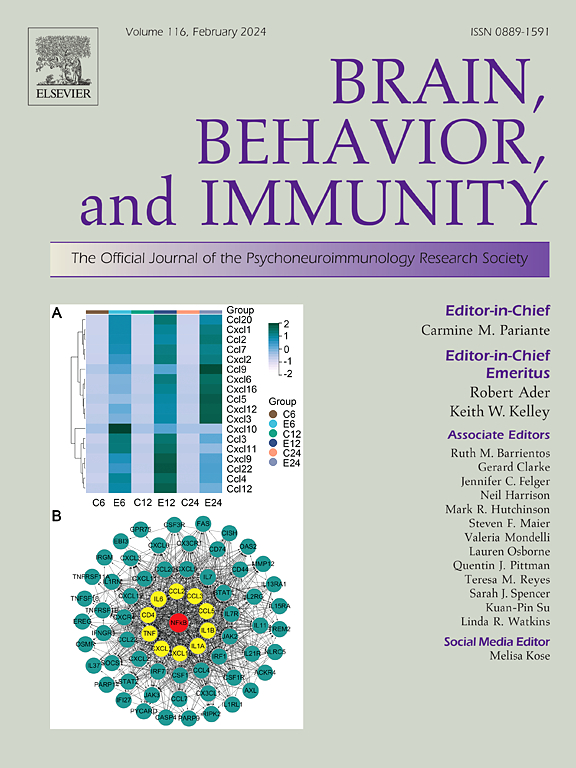戒断期重度酒精使用障碍患者TNFR1和TNFR2水平及其与震颤性谵妄的关系
IF 7.6
2区 医学
Q1 IMMUNOLOGY
引用次数: 0
摘要
背景:长期饮酒与细胞因子失调有关。肿瘤坏死因子-α (TNF-α)通过两种不同的受体- TNF受体1型(TNFR1)和TNF受体2型(TNFR2)介导,在酒精使用障碍(AUD)中发挥作用。证据还表明TNFR1和TNFR2在谵妄发展中的潜在作用。我们的目的是研究TNFR1和TNFR2在AUD停药患者中的作用,以及这些水平在伴有和不伴有震颤谵妄(DT)的患者中的差异。方法选取90例寻求治疗的严重AUD患者和117例健康对照(HC),采用酶联免疫吸附法检测血液中TNF-α、TNFR1和TNFR2的水平。我们在停药2周后跟踪AUD组的水平,并根据该段时间内DT (DT组,n = 19)和非DT组(n = 71)的发生情况进行分类。结果在第0周和第2周,AUD患者的血浆TNFR1、TNFR2和TNF-α水平均高于健康对照组,DT亚组高于非DT亚组。尽管戒酒两周后水平有所下降,但与对照组相比仍处于较高水平。回归分析显示,年龄、性别和TNF-α水平是影响TNFR1和TNFR2水平的重要因素。该研究首次表明,在早期戒断后,AUD患者的TNFR1和TNFR2水平升高,但降低,但未正常化。与非DT亚组相比,DT亚组与更严重的TNFR1和TNFR2失调相关。本文章由计算机程序翻译,如有差异,请以英文原文为准。

TNFR1 and TNFR2 levels in patients with severe alcohol use disorder undergoing withdrawal and their relationship with delirium tremens
Background
Chronic alcohol consumption has been associated with cytokine dysregulation. Tumor necrosis factor-alpha (TNF-α), mediated through two distinct receptors—TNF receptor type 1 (TNFR1) and TNF receptor type 2 (TNFR2)—plays a role in alcohol use disorder (AUD). Evidence also suggests a potential role of TNFR1 and TNFR2 in delirium development. We aimed to investigate the role of TNFR1 and TNFR2 in patients with AUD undergoing withdrawal and the differences in these levels between those with and without delirium tremens (DT).
Methods
Ninety treatment-seeking patients with severe AUD and 117 healthy controls (HC) were enrolled and measured for blood levels of TNF-α, TNFR1 and TNFR2 using enzyme-linked immunosorbent assays. We followed the levels in AUD group after 2 weeks of withdrawal and categorized them based on the occurrence of DT (DT group, n = 19) and non-DT group (n = 71) during this period.
Results
At both week 0 and week 2, patients with AUD had higher plasma TNFR1, TNFR2, and TNF-α levels than healthy controls, with the DT subgroup showing greater elevations than the non-DT subgroup. Although levels declined after two weeks of alcohol withdrawal, they remained elevated compared to controls. Regression analysis indicated that age, sex, and TNF-α levels were significant contributors to TNFR1 and TNFR2 levels.
Conclusions
This study is the first to indicate that TNFR1 and TNFR2 levels were increased in patients with AUD but decreased, though not normalized, after early abstinence. DT subgroup is associated with more severe TNFR1 and TNFR2 dysregulation than non-DT subgroup.
求助全文
通过发布文献求助,成功后即可免费获取论文全文。
去求助
来源期刊
CiteScore
29.60
自引率
2.00%
发文量
290
审稿时长
28 days
期刊介绍:
Established in 1987, Brain, Behavior, and Immunity proudly serves as the official journal of the Psychoneuroimmunology Research Society (PNIRS). This pioneering journal is dedicated to publishing peer-reviewed basic, experimental, and clinical studies that explore the intricate interactions among behavioral, neural, endocrine, and immune systems in both humans and animals.
As an international and interdisciplinary platform, Brain, Behavior, and Immunity focuses on original research spanning neuroscience, immunology, integrative physiology, behavioral biology, psychiatry, psychology, and clinical medicine. The journal is inclusive of research conducted at various levels, including molecular, cellular, social, and whole organism perspectives. With a commitment to efficiency, the journal facilitates online submission and review, ensuring timely publication of experimental results. Manuscripts typically undergo peer review and are returned to authors within 30 days of submission. It's worth noting that Brain, Behavior, and Immunity, published eight times a year, does not impose submission fees or page charges, fostering an open and accessible platform for scientific discourse.

 求助内容:
求助内容: 应助结果提醒方式:
应助结果提醒方式:


